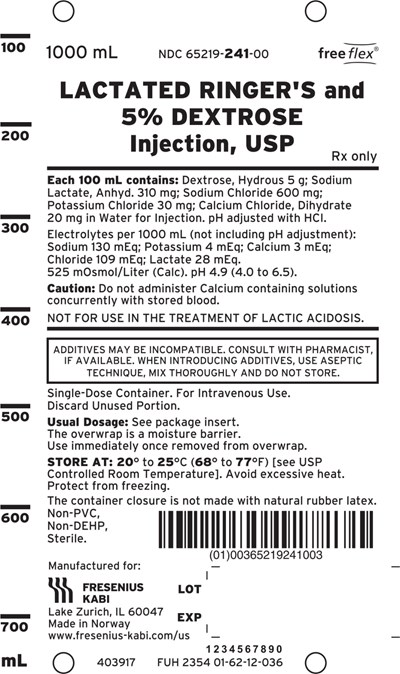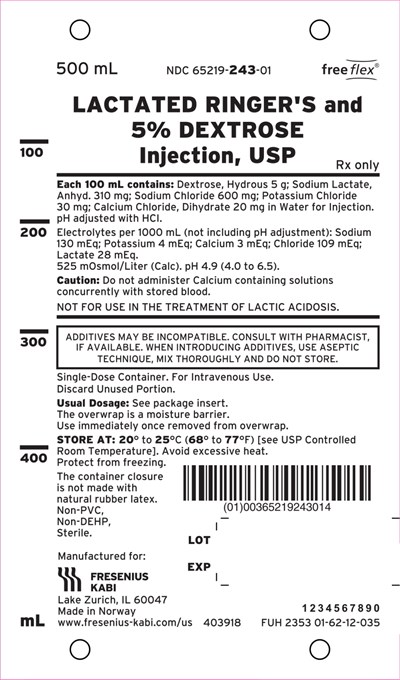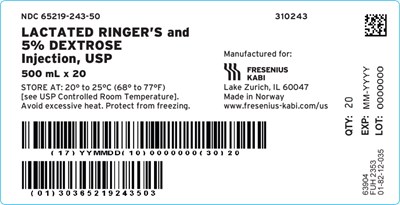FDA Label for Lactated Ringers And Dextrose
View Indications, Usage & Precautions
- OTHER
- DESCRIPTION
- CLINICAL PHARMACOLOGY
- INDICATIONS AND USAGE
- CONTRAINDICATIONS
- WARNINGS
- PRECAUTIONS
- PREGNANCY
- PEDIATRIC USE
- ADVERSE REACTIONS
- OVERDOSAGE
- DOSAGE AND ADMINISTRATION
- DRUG INTERACTIONS
- HOW SUPPLIED
- INSTRUCTIONS FOR USE
- PACKAGE LABEL.PRINCIPAL DISPLAY PANEL
- PACKAGE LABEL - PRINCIPAL DISPLAY – LACTATED RINGER'S AND 5% DEXTROSE INJECTION, USP 500 ML BAG LABEL
- PACKAGE LABEL - PRINCIPAL DISPLAY –LACTATED RINGER'S AND 5% DEXTROSE 500 ML CASE LABEL
Lactated Ringers And Dextrose Product Label
The following document was submitted to the FDA by the labeler of this product Fresenius Kabi Usa, Llc. The document includes published materials associated whith this product with the essential scientific information about this product as well as other prescribing information. Product labels may durg indications and usage, generic names, contraindications, active ingredients, strength dosage, routes of administration, appearance, warnings, inactive ingredients, etc.
Other
Flexible Plastic Container
Rx only
Description
The product is sterile, nonpyrogenic solution containing isotonic concentration of electrolytes with dextrose in water for injection. The solutions containing dextrose and electrolytes are hypertonic. They are administered by intravenous infusion for parenteral replacement of extracellular losses of fluid and electrolytes, with minimal carbohydrate calories.
Each 100 mL of Lactated Ringer's and 5% Dextrose Injection, USP contains dextrose, hydrous 5 g, sodium chloride 600 mg, sodium lactate, anhydrous 310 mg, potassium chloride 30 mg and calcium chloride, dihydrate 20 mg. Contains only hydrochloric acid for pH adjustment. A liter provides 179 calories (from dextrose and lactate), sodium (Na+), 130 mEq, potassium (K+) 4 mEq, calcium (Ca++) 3 mEq, chloride (Cl−) 109 mEq and lactate [CH3CH(OH) COO−] 28 mEq and has a hypertonic osmolar concentration of 525 mOsmol (calc.). The pH is 4.9 (4.0 − 6.5).
The solution contains no bacteriostat, antimicrobial agent or added buffer (except for pH adjustment) and is intended only for use as a single-dose injection. When smaller doses are required the unused portion should be discarded.
This solution is a parenteral fluid, nutrient and/or electrolyte replenishers.
Dextrose, USP is chemically designated D-glucose, monohydrate (C6H12O6 • H2O), a hexose sugar freely soluble in water.
It has the following structural formula:
Calcium Chloride, USP is chemically designated calcium chloride dihydrate (CaCl2 • 2 H2O), white fragments or granules freely soluble in water.
Potassium Chloride, USP is chemically designated KCl, a white granular powder freely soluble in water.
Sodium Chloride, USP is chemically designated NaCl, a white crystalline powder freely soluble in water.
Sodium Lactate, USP is chemically designated monosodium lactate [CH3CH(OH)COONa], a 50% aqueous solution miscible in water.
It has the following structural formula:
Water for Injection, USP is chemically designated H2O.
The flexible plastic container is fabricated from a specially formulated non-plasticized, film containing polypropylene and thermoplastic elastomers (freeflex® bag). Water can permeate from inside the container into the overwrap but not in amounts sufficient to affect the solution significantly. Solutions inside the plastic container also can leach out certain of their chemical components in very small amounts before the expiration period is attained. However, the safety of the plastic has been confirmed by tests in animals according to USP biological standards for plastic containers.
Clinical Pharmacology
When administered intravenously, these solutions provide sources of water and electrolytes with minimal carbohydrate calories. Their electrolyte content resembles that of the principal ionic constituents of normal plasma and the solutions therefore are suitable for parenteral replacement of extracellular losses of fluid and electrolytes, with carbohydrate calories.
Solutions containing carbohydrate in the form of dextrose restore blood glucose levels and provide calories.
Carbohydrate in the form of dextrose may aid in minimizing liver glycogen depletion and exerts a protein-sparing action. Dextrose injected parenterally undergoes oxidation to carbon dioxide and water.
Calcium chloride in water dissociates to provide calcium (Ca++) and chloride (Cl-) ions. They are normal constituents of the body fluids and are dependent on various physiologic mechanisms for maintenance of balance between intake and output. Approximately 80% of body calcium is excreted in the feces as insoluble salts; urinary excretion accounts for the remaining 20%.
Potassium chloride in water dissociates to provide potassium (K+) and chloride (Cl-) ions. Potassium is found in low concentration in plasma and extracellular fluids (3.5 to 5.0 mEq/liter in a healthy adult). It is the chief cation of body cells (160 mEq/liter of intracellular water). Potassium plays an important role in electrolyte balance. Normally about 80 to 90% of the potassium intake is excreted in the urine; the remainder in the stools and to a small extent, in the perspiration. The kidney does not conserve potassium well so that during fasting or in patients on a potassium-free diet, potassium loss from the body continues resulting in potassium depletion.
Sodium chloride in water dissociates to provide sodium (Na+) and chloride (Cl-) ions. Sodium (Na+) is the principal cation of the extracellular fluid and plays a large part in the therapy of fluid and electrolyte disturbances. Chloride (Cl-) has an integral role in buffering action when oxygen and carbon dioxide exchange occurs in the red blood cells. The distribution and excretion of sodium (Na+) and chloride (Cl-) are largely under the control of the kidney which maintains a balance between intake and output.
Sodium lactate provides (Na+) and lactate (C3 H5 O3-) ions. The lactate anion is in equilibrium with pyruvate and has an alkalizing effect resulting from simultaneous removal by the liver of lactate and hydrogen ions. In the liver, lactate is metabolized to glycogen which is ultimately converted to carbon dioxide and water by oxidative metabolism. The sodium (Na+) ion combines with bicarbonate ion produced from carbon dioxide of the body and thus retains bicarbonate to combat metabolic acidosis (bicarbonate deficiency). The normal plasma level of lactate ranges from 0.9 to 1.9 mEq/liter.
Water is an essential constituent of all body tissues and accounts for approximately 70% of total body weight. Average normal adult daily requirement ranges from two to three liters (1.0 to 1.5 liters each for insensible water loss by perspiration and urine production).
Water balance is maintained by various regulatory mechanisms. Water distribution depends primarily on the concentration of electrolytes in the body compartments and sodium (Na+) plays a major role in maintaining physiologic equilibrium.
Indications And Usage
These solutions are indicated for parenteral replacement of extracellular losses of fluid and electrolytes, with minimal carbohydrate calories, as required by the clinical condition of the patient.
Contraindications
Solutions containing lactate are NOT FOR USE IN THE TREATMENT OF LACTIC ACIDOSIS.
Warnings
Solutions containing calcium ions should not be administered simultaneously through the same administration set as blood because of the likelihood of coagulation.
Solutions which contain potassium should be used with great care, if at all, in patients with hyperkalemia, severe renal failure and in conditions in which potassium retention is present.
Solutions containing sodium ions should be used with great care, if at all, in patients with congestive heart failure, severe renal insufficiency and in clinical states in which there exists edema with sodium retention.
In patients with diminished renal function, administration of solutions containing sodium or potassium ions may result in sodium or potassium retention.
Solutions containing lactate ions should be used with great care in patients with metabolic or respiratory alkalosis. The administration of lactate ions should be done with great care where there is an increased level or an impaired utilization of lactate ions, as in severe hepatic insufficiency.
The intravenous administration of these solutions can cause fluid and/or solute overloading resulting in dilution of serum electrolyte concentrations, overhydration, congested states or pulmonary edema. The risk of dilutional states is inversely proportional to the electrolyte concentrations of administered parenteral solutions.
The risk of solute overload causing congested states with peripheral and pulmonary edema is directly proportional to the electrolyte concentrations of such solutions.
Precautions
Clinical evaluation and periodic laboratory determinations are necessary to monitor changes in fluid balance, electrolyte concentrations and acid-base balance during prolonged parenteral therapy or whenever the condition of the patient warrants such evaluation.
Solutions containing dextrose should be used with caution in patients with known subclinical or overt diabetes mellitus.
Caution must be exercised in the administration of parenteral fluids, especially those containing sodium ions, to patients receiving corticosteroids or corticotropin.
Potassium containing solutions should be used with caution in the presence of cardiac disease, particularly in digitalized patients or in the presence of renal disease.
Solutions containing lactate ions should be used with caution as excess administration may result in metabolic alkalosis.
Do not administer unless solution is clear and container is undamaged. Discard unused portion.
Pregnancy
Pregnancy Animal reproduction studies have not been conducted with Ringer's Injection, USP, Ringer's and Dextrose Injection, USP, Lactated Ringer's Injection, USP or Lactated Ringer's and Dextrose Injection, USP. It is also not known whether these injections can cause fetal harm when administered to a pregnant woman or can affect reproduction capacity. These injections should be given to a pregnant woman only if clearly needed.
Pediatric Use
Pediatric Use The safety and effectiveness in the pediatric population are based on the similarity of the clinical conditions of the pediatric and adult populations. In neonates or very small infants the volume of fluid may affect fluid and electrolyte balance.
Frequent monitoring of serum glucose concentrations is required when dextrose is prescribed to pediatric patients, particularly neonates and low birth weight infants.
In very low birth weight infants, excessive or rapid administration of dextrose injection may result in increased serum osmolarity and possible intracerebral hemorrhage.
Adverse Reactions
Reactions which may occur because of the solution or the technique of administration include febrile response, infection at the site of injection, venous thrombosis or phlebitis extending from the site of injection, extravasation and hypervolemia.
If an adverse reaction does occur, discontinue the infusion, evaluate the patient, institute appropriate therapeutic countermeasures and save the remainder of the fluid for examination if deemed necessary.
To report SUSPECTED ADVERSE REACTIONS, contact Fresenius Kabi USA, LLC at 1-800-551-7176 or FDA at 1-800-FDA-1088 or www.fda.gov/medwatch.
Overdosage
In the event of overhydration or solute overload, re-evaluate the patient and institute appropriate corrective measures. See WARNINGS, PRECAUTIONS, and ADVERSE REACTIONS.
Dosage And Administration
The dose is dependent upon the age, weight and clinical condition of the patient.
As reported in the literature, the dosage and constant infusion rate of intravenous dextrose must be selected with caution in pediatric patients, particularly neonates and low birth weight infants, because of the increased risk of hyperglycemia/hypoglycemia.
Drug Interactions
Additives may be incompatible. Consult with pharmacist, if available. When introducing additives, use aseptic technique, mix thoroughly and do not store.
The presence of calcium limits their compatibility with certain drugs that form precipitates of calcium salts, and also prohibits their simultaneous infusion through the same administration set as blood because of the likelihood of coagulation.
Parenteral drug products should be inspected visually for particulate matter and discoloration prior to administration, whenever solution and container permit. See PRECAUTIONS.
How Supplied
Lactated Ringer's and 5% Dextrose Injection, USP is supplied in single-dose freeflex® plastic containers as follows:
| Product Code | Unit of Use | Unit of Sale |
| 310241 | NDC 65219-241-00 One 1000 mL freeflex® bag | NDC 65219-241-10 Package of 10 freeflex® bags |
| 310243 | NDC 65219-243-01 One 500 mL freeflex® bag | NDC 65219-243-50 Package of 20 freeflex® bags |
Store at 20 to 25°C (68 to 77°F). [See USP Controlled Room Temperature.] Avoid excessive heat. Protect from freezing.
The container closure is not made with natural rubber latex. Non-PVC, Non-DEHP, Sterile.
Instructions For Use
Check flexible container solution composition, lot number, and expiry date.
Do not remove solution container from its overwrap until immediately before use. Use sterile equipment and aseptic technique.
Flexible Plastic Container (freeflex® bag)
To Open
- Turn solution container over so that the text is face down. Using the pre-cut corner tabs, peel open the overwrap and remove solution container.
- Check the solution container for leaks by squeezing firmly. If leaks are found, or if the seal is not intact, discard the solution.
- Do not use if the solution is cloudy or a precipitate is present.
- Identify WHITE Additive Port with arrow pointing toward container.
- Immediately before injecting additives, break off WHITE Additive Port Cap with the arrow pointing toward container.
- Hold base of WHITE Additive Port horizontally.
- Insert needle horizontally through the center of WHITE Additive Port's septum and inject additives.
- Mix container contents thoroughly.
- Immediately before inserting the infusion set, break off BLUE Infusion Port Cap with the arrow pointing away from container.
- Use a non-vented infusion set or close the air-inlet on a vented set.
- Close the roller clamp of the infusion set.
- Hold the base of BLUE Infusion Port.
- Insert spike through BLUE Infusion Port by rotating wrist slightly until the spike is inserted.
NOTE: See full directions accompanying administration set.
To Add Medication
Preparation for Administration
WARNING: Do not use flexible container in series connections.
Manufactured for:
Lake Zurich, Illinois 60047
Made in Norway
451770
www.fresenius-kabi.com/us
Issued: September 2022
Package Label.Principal Display Panel
PACKAGE LABEL - PRINCIPAL DISPLAY –Lactated Ringer's and 5% Dextrose Injection, USP 1000 mL Bag Label
1000 mL NDC 65219-241-00 freeflex®
LACTATED RINGER'S and 5% DEXTROSE Injection, USP
Rx only
PACKAGE LABEL - PRINCIPAL DISPLAY –Lactated Ringer's and 5% Dextrose 1000 mL Case Label
NDC 65219-241-10 310241
LACTATED RINGER'S and 5% DEXTROSE Injection, USP
1000 mL x 10
STORE AT: 20° to 25°C (68° to 77°F)
[see USP Controlled Room Temperature].
Avoid excessive heat. Protect from freezing.
Package Label - Principal Display – Lactated Ringer's And 5% Dextrose Injection, Usp 500 Ml Bag Label
500 mL NDC 65219-243-01 freeflex®
LACTATED RINGER'S and
5% DEXTROSE
Injection, USP
Rx only
Package Label - Principal Display –Lactated Ringer's And 5% Dextrose 500 Ml Case Label
NDC 65219-243-50 310243
LACTATED RINGER'S and 5% DEXTROSE Injection, USP
500 mL x 20
STORE AT: 20° to 25°C (68° to 77°F)
[see USP Controlled Room Temperature].
Avoid excessive heat. Protect from freezing.
* Please review the disclaimer below.





